“Try to focus on one thing – it could be one colour, one idea, any one thing, really,” instructed our photo-tour guide Gavin Gough. “Don’t just wander around taking pictures of everything!”
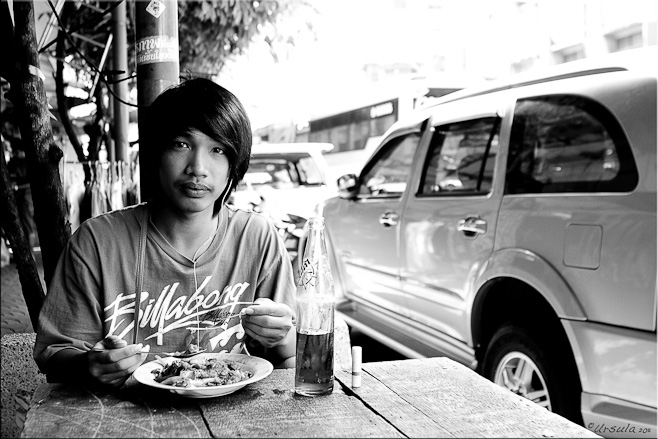 Young Thai Eating Breakfast, Yaowarat Now, I have enormous respect for Gavin, Bangkok-based travel photographer and teacher extraordinaire, but I was about to head into Yaowarat, Bangkok’s Chinatown, for the morning with a small group of other aspiring photographers. Trying to follow the advice to ‘focus’ in this richly textured neigbourhood, seemed an impossible task! For me, being in Chinatown with a camera is a bit like being a kid in a candy store. The environment is a sensory feast: chaotic colours are piled on top of each other in narrow shops and in bins on any available pavement; the heat and humidity are pervasive, accentuating the humming energy and the somewhat claustrophobic atmosphere; the noise of machinery combines with chatter and barter in several languages; shoppers jostle with tourists, giving way to motorcycles and coolies with over-laden trolleys. I do feel the impulse to photograph everything!
Luckily for me, the first exercise Gavin gave us was to shoot some black and white frames with a wide angle to try to draw attention to one thing. This exercise quieted my humming senses, and my target for the day came to the forefront: I decided that that I would focus on the people .
So, here are a few of the people of Bangkok’s Chinatown, going about their daily business.
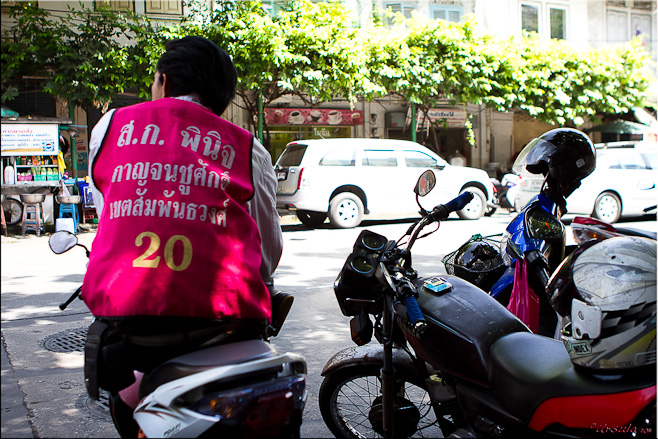 Motorcycle taxi drivers in their candy colours wait for customers. 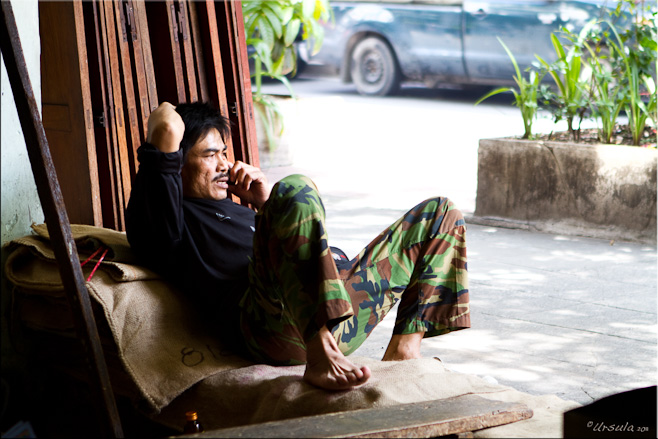 A labourer at the peanut- and rice-seller's shop takes five.  Proud owner surveying his domain ~ He offered us delicious samples of his peanuts, rice and fruit.  Break time is over ~ and the labourer is back to work moving peanuts.  Smiling while he works: another labourer moving more peanuts.  Three children of local shop-keepers pause from their colouring to give me big smiles.  In the Madding Crowd ~ People Everywhere!  An enormous Lady Luck welcomes you into the area.  It might be early morning, but some workers have had long nights!  It's hard to stay engaged when you have no customers!  A matriarch keeps an eye on proceedings.  Cleaning fresh fish for sale, Yaowarat  Scaling the fish, Yaowarat  Bagging Loquat (Japanese medlar, Nispero) for desserts.  I asked this woman selling chicken feet how long she'd been working in the markets... I didn't want to do the impolite thing and ask her age!  Sixty years, she told me. She started work as a young girl, bagging spices.  A young man looks out between the birds at the Chinese duck noodle shop  Having reached the end of Chinatown, we climbed in a tuk tuk for the short ride back to the pier.  The Sun has Set, Wat Arun, Bangkok  Later that evening as we had drinks watching the darkness descend over Wat Arun, I couldn’t help but think about the variety of people, activities and occupations in that one small area in Yaowarat. Our daily lives are all so different, but with a little bit of work, they can all fit together. Later that evening as we had drinks watching the darkness descend over Wat Arun, I couldn’t help but think about the variety of people, activities and occupations in that one small area in Yaowarat. Our daily lives are all so different, but with a little bit of work, they can all fit together.
Where ever you are, whatever you are doing, happy travels!
Posted in Culture,Every Day Life,Thailand,Travel,WorkTags: Bangkok,blog,children,Chinatown,fish,market,people,Photo Blog,Thailand,travel,Travel Blog,Ursula Wall,work,Yaowarat
The English word ‘souvenir’ comes from the same word in French; in French le souvenir can be the memory itself, or, as it is in English, the keepsake in which the memory is signified. Photographs are my mementos, my souvenirs, but some of my clearest memories of our long walk in the Pyrenees never made it onto the camera.
Mealtimes, for example.
In Granès, on the eve of our sixth day, we dined at long tables with a dozen or so French-speaking horse-riding tour-guides! A circuit of les “Châteaux Cathares” (the “Cathar Castles”) is often done by horseback and our lodging in Granès is a common transfer point. We happened to be in town on the same day as the end of one equestrian circuit and the start of another, so there was lively conversation around our table: amongst the two sets of guides, who came from all over France, and ourselves, when my French could keep up. I’m not sure if it was all the wine, or trying to process the crossfire of conversation in a language that I struggle with, but the next morning as we set off again, my head was still buzzing with a pastiche of sound snippets and image fragments from the night before.
 Granes (with or without its accent grave è) wakes up slowly as the cavaliers (horse riders) get together to plan their day.  Rural Abstract: Discarded, Rusting Machinery ~ Granes, Limoux, Aude  Fields of Mustard in Bloom ~ Granes Trip Notes: Day 6: Granes to Quillan
The route from Granes to Quillan follows the GR (“GR®” Grandes Randonnées / Long Distance Footpaths) along a well known path that used to be an important link and means of communication between the small Pyreneen hamlets. We traverse the high saddle of the Col des Trois Quilles before arriving in Quillan.
Points of Interest: Typical traditional Pyrenean villages and the Col des Trois Quilles viewpoint
18 kms/11.25 miles. 5hrs. Altitude gain/descent: +350m -440m
The first half of our walk was through woods and countryside, interspersed with tiny villages. Granès had a population of only 124 people in 2007, and the nearby towns are of similar sizes. In the morning, although part of our walk was on bitumen, the only vehicle we passed was the regional mail van, and the only others we noticed were tractors in the fields and a Citroën, parked in its old garage.
 Small Flowers on the Forest Floor  Roses in the Garden ~ Saint Ferriol  Old Citroën; Old Garage ~ Sant Ferriol (Population 142)  Cypress (Cupressus) Trees ~ Domaine Sainte Eugénie  Checking the Maps and Notes ~ Saint-Julia-de-Bec (Population 119)  Daisies on the Verge ~ These always remind me of childhood trips to Stanley Park (Vancouver): I'd look for the pinkest daisy I could find, but when I picked it, it would look plain white.... Just another of the many plants that look best where they grow naturally!  Les Chevaux - Horses ~ Saint-Julia-de-Bec  Gorse on the Verge ~ Saint-Julia-de-Bec  Spring Apple Blossoms ~ Saint-Julia-de-Bec  Next Year's Wine? New Vines  Tiny Wildflowers in the Wind  Last season's last oak leaf clings to the branch amid new growth: This made me think of the O. Henry short story: "The Last Leaf"  Everlasting? Forest Floor, Aude, Languedoc-Roussillon  Wild Violet, Forest Floor, Aude, Languedoc-Roussillon  Looking Down from the Col de Quilles (Ninepins, Skittles) to Belvianes-et-Cavirac (Pop. 285)  Quillan ~ Old Ruins, Newer Town  Castle Walls ~ Quillan Castle Ruins  I thought these were lilacs, but on closer inspection, they are more like a pea, broom or gorse.  Quillan and the River Aude from the Castle  Le Pont Vieux; The Old Bridge (11-12th Century) over the River Aude ~ Quillan For us, one of the nicest things about this day was that the Trip Notes were relatively believable! After the five hours suggested walking time, we were actually sitting in the sun in the centre of Quillan, drinking coffee and beer, and people watching.
Because Quillan is a town of reasonable size (population 3,406 in 2007) we were booked into a hotel and needed to find our own dinner. We were reading the ‘Specials’ outside an Italian restaurant when the owner leaned out of an upstairs window and directed us to the English menu on the opposite side of the sign-board. He knew no self-respecting French person would be reading a dinner menu at only six in the evening! They wouldn’t even be open for another hour, so we sat outside the tabac downstairs for some kir, and some more people watching. A sketch artist would have had a field day – though many many of the resulting drawings could easily be mistaken for caricatures.
It was the Saturday eve of Palm Sunday, and a parade of residents filed past us on their way home after church, clutching small boughs of greenery representing palms. Old men in battered felt hats and shiny grey suits shuffled along side matronly women in black dresses, black sweaters, and kerchiefs. An impossibly thin, tall woman with her grey hair pinned in a perfect french roll, wearing oversized pearls and a cream and navy wool suit, circa 1960’s, crossed the plaza with her friends, similarly decked out in Sunday best that looked as if it had been washed, polished and mended every week for forty-plus years. In ancient times, Quillan was a major stop-over between Carcassonne with Perpignan. Today, the population is not only reducing with each census since the mid-seventies, it is ageing significantly and a staggering 17% of residents are 75 or older.
The evening ‘bar’ crowd sharing the tabac with us were of two different groups, distinct from the church-attenders. A small group of round-faced middle-aged male British expats with large bellies and large beers alternated between their outside smoking table and watching the soccer match on TV indoors, while a larger loose group of Hispanic-speaking itinerant workers came and went, kissing cheeks with each other, sitting, sharing news, smoking gitanes and drinking pastisse (the ubiquitous anisette liquor) before kissing cheeks again and moving on. Resembling gypsies of old, these people all had black hair, dark colouring, and handsome angular features. One bent-over tiny old man with a wizened face, tattoos, earings and dread-locked hair limped in with his large pack and medium-sized dog, like a character out of a French version of Charles Dickens.
 How I would have loved to have taken pictures! How I would have loved to have taken pictures!
But, sometimes it does not feel appropriate to ask. More mental images that never made it onto the camera ~ mes souvenirs ~ my memories.
Posted in Culture,Every Day Life,France,Nature,Religious Practice,RuralTags: architecture,blog,France,nature,people,Photo Blog,religion,rural,Sentier Cathare,The Cathar Trail,The Cathar Way,travel,Travel Blog,Ursula Wall,walk,worship
 For the Future of Thai Children, (amongst other things) One PC Each and Free WiFi… Thailand goes to the polls this Sunday. For weeks, the streets of Bangkok have been lined with colourful political posters: posters with pictures of bland-faced politicians and their pork-barrel promises of fiscal payouts to just about every demographic; posters of “everywoman” in her tennis whites and “everyman” in his golf gear; posters depicting the candidates as animals (a grievous insult) and exhorting people not to vote at all; pictures of a massage-parlour operator campaigning “against corruption”; and my personal favourite: a poster in official Thai flag colours promising WiFi and a free PC to every schoolchild.
Now, call me cynical, but having just recently returned from another trip to visit schools in “The Hills” of Thailand, I can think of many things that these children need more than their own individual PCs! Like: dorms with enough space for all the pupils who want to study but live too far from school; some proper bunks and some new bedding; somewhere to do their laundry; a spare uniform; a pair of new shoes; a canteen with a clean floor and enough tables and chairs; more teachers and auxiliary staff to help in over-crowded classrooms; the list goes on.
Historically, successive Thai governments have provided the barest of essentials for public schooling. True, Thailand is a “developing country”, but even so, it is well down the international ranks in terms of percentage GDP allocated to education (just 4.1% in 2009). The current government increased educational access to 15 years: three years of pre-school and grades 1 through 12, and it is true that 18% of government expenditure is on education, but this is in the context of low tax revenues and weak spending overall. In remote and marginalised Hilltribe communities, many of the auxiliary buildings in and around the local schools are funded, not by the government, but by charitable organisations.
At the end of May, just as the new school year was about to start, I was able to visit some schools in Mae Hong Son province in northern Thailand, with Susan Race, founder and manager of THEP – Thailand Hilltribe Education Projects, one of these charitable organisations. I’ve been on these trips before (see: Budding Potentials, Building Futures, and Schools), and what always impresses me – other than the beauty of the countryside – is the cheerful resilience of the local people.
The highlight of this particular trip was our stay at the school at Mae Lit and visiting the local community where the predominantly Karen people eke out a living growing cabbages and rice. We arrived on a Sunday, the last day of school holidays and stayed for the ‘official’ school opening.
 Stopping for a Chat ~ Proud Father of a University Scholarship Recipient  Side by Side ~ Karen Couple in Front of Rice Terraces, Ready for Planting  Seven-Year-Old Ornwara is Starting Grade One Tomorrow! She is one of Sixty Students Accommodated in Three Dorm Rooms at the School  The First-Graders: Ornwara’s parents won’t be there to watch her start school tomorrow – they live too far away – but she has her friends to keep her company.  Airing the Laundry ~ Typical Karen House, Mae Lit  Always a Smile for the Visitors ~ Karen Boy, Mae Lit  View from the Balcony ~ Karen Girl, Mae Lit  Frail Granny with Hand Tattoos Watches From Next Door  Bringing Home the Buffalo ~ Mae Lit  Extended Family at Home ~ Mae Lit  Making Ties for Rice Planting  Afternoon Light Over the Hills ~ They’ve had electricity here for a year or so, but it is still hard to know where they would put all those PCs! On Monday morning the dormitory children got up early to dress, cook themselves breakfast, eat, wash the dishes and do housekeeping chores before the school bell rang.
 Monday Morning Before First Day of Term: The Children Go About their Morning Tasks  Spicy Vegetables for Breakfast  Kitchen Chores ~ Mae Lit School  Readying the School for Opening  Kids, Bikes and Dogs ~ A generous benefactor donated a number of bicycles to the school, so the children had a nice surprise for their first day back.  Lines of Official Thai School-Girl Hair-Cuts  Monk Presiding  Susan Chats to a Young Scholarship Recipient  Torch Ginger (Zingiberaceae) in the Schoolyard  Fragrant and Impossibly Green ~ Early Rice on the Road Back Down Out of The Hills These are some of the poorest villages in the country, where life changes slowly. The days in the fields are long and hard, so it is tempting to keep older children home to help. Many families have virtually no income, making it impossible to pay for uniforms, books, travel, and all the other things the government doesn’t provide for school-aged children. But, traditions are strong, communities are bonded and food is plentiful. The children at these schools are helpful, polite and wonderfully self-reliant. I have nothing against them having ready access to PCs – there is just so much else that they need more!
Regardless of who wins the next election, I have little faith that it will result in any major improvements in these communities. For these children to participate fully in the education that is theoretically available, but practically just out of reach, they will continue to need the help of “outsiders”. Susan will be visiting the students and the projects she manages again in November. If you are prepared to eat local (fresh and delicious!), travel rough on roads that sometimes disappear, and sleep on the odd floor (with mats and bedding), I know she’d love to have you along to see what is needed for yourself. and sleep on the odd floor (with mats and bedding), I know she’d love to have you along to see what is needed for yourself.
In the meantime, happy travels.
Posted in Culture,Education,Every Day Life,Rural,Thailand,Travel,WorkTags: blog,children,education,farm,farming,flowers,Mae Hong Son,nature,people,Photo Blog,rural,thai,Thailand,travel,Travel Blog,Ursula Wall,work
 Blue and White ~ Siam Ceramics ~ Bangkok Sky Pottery is one of the markers of ‘civilisation’. With archeological examples dating back to B.C. 3,600, Thailand’s pottery traditions are amongst the oldest in the world. Over the years clear regional styles developed, with the quality of the products largely dependent on the types of clay found in the area.
Ceramics traditions also crossed borders: with the migrations of people and as a commodity across the region. For example, King Ramkamhaeng (1279-1298) brought potters from China to set up the now-famous Sukhothai kiln, and 600 to 800 more kilns were built around the region using the imported technology during the Sukothai period.
Today many of the small cottage industries in the Thai ceramics business make Chinese-style pottery, with one of the most popular being the ‘blue and white’ under-glazed porcelain, sometimes called ‘Ming’ porcelain (although the style originated in the earlier (1127 – 1279) Yuan dynasty).
 Siam Ceramic “House of Blue and White Pottery” Shop Front  Blue and White ~ In the Ming (1368 – 1644) Tradition Over the last fifteen years, Thai ceramics producers have repositioned themselves to become significant international exporters. They have used the quality of their products to compete favourably against regional rivals (China, the Philippines, Indonesia and Malaysia) in the the United States, Japan, Hong Kong, Australia and United Kingdom markets.
In addition to the popular blue and white pottery, Thailand is famous for its celadon: high-fired stonewares with the distinctively crackled feldspathic and wood-ash glazes. The traces of iron in the clay, or in the glaze formulation itself, give celadon its characteristic colours: greens that are almost-white, subtly grayed, honey yellow, brown, rich Jade or olive.
Benjarong, another traditional Thai porcelain, has its roots in the Ming dynasty style of painting enamels onto a white porcelain base. The Thai name ‘Benjarong’ is from the Pali and Sanskrit words Benja and Rong, meaning ‘Five Colours’, and is descriptive: five enamel colours (red, white, yellow, black and green) are most commonly used, although some Benjarong patterns use only three colours, while others have as many as eight. Gold is liberally featured and the intricately repeated patterns are applied much more thickly than in the earlier Chinese examples, giving a highly textured finish.
 The ‘Five Colours’ of Benjaron ~ With the Liberal Applications of Gold  The “Chakri Blue” Benjarong Pattern  Individually Applied ‘Wool’ Buttons on a Ceramic Sheep  The Ubiquitous Thai Elephant ~ in Blue and White Last month I was able to visit two porcelain factory outlets close to Bangkok for a small glimpse of the quality and range of Thai ceramic products. I was travelling with a group of women from ANZWG (the Australian New Zealand Women’s Group), and so we were invited ‘backstage’. “If they had shown us the workroom first, I would have appreciated the pieces even more!” exclaimed one of the women as we watched the men at work. For while the kilns and potters’ wheels might be greatly improved over what they were a thousand years ago, much of the process of creating beautiful ceramics has remained unchanged. Every piece is painstakingly painted by hand – a fact that is NOT, by Western standards, reflected in the local selling prices.
 Chinese Shar-Pei Guarding the Workshop Entrance  Ceramic Greenware Babies  Women Shopping while the Greenware Dries  Delicate Work ~ Underglazing the Blue and White Porcelain  Siamese Aristocats? Greenware in the Workroom  Artisan at Work: Three days for a piece this size, he told me.  Storeroom: Blue and White Pots and Celadon Buddhas  Blue ~ White ~ and a Generous Brush of Gold  Lids: Blue ~ White ~ and Gold  Ceramic Tiles and Pots at the Chieng Sang Factory Outlet Sitting on our balcony later that evening, watching the storm clouds rolling in over a city of shiny ceramic-glazed high rise buildings, I couldn’t help but think about how ceramics define modern ‘civilisation’ – being used for everything from teeth to tiles, from car parts to communications, from everyday kitchen products to aerospace. At the same time, Thai pottery traditions continue to evolve as they have for six thousand years.
 Blue ~ White ~ and Gold  Blue and white ceramics are like a symbolic bridge between the past and the future. Blue and white ceramics are like a symbolic bridge between the past and the future.
And, an example of the time and effort that goes into things of beauty.
Happy travels!
Posted in Culture,Fine Arts,Thailand,Travel,WorkTags: arts and crafts,Bay of Thailand,blog,ceramics,people,Photo Blog,pottery,travel,Travel Blog,Ursula Wall,work
 Almost Abstract: Rusty Machinery Parts, Sougraigne We were in the car, in Australia, driving to an appointment last month, when my husband remarked: “You know, it took us two weeks to walk this same distance!”
It’s true – we routinely cover great distances driving without giving it much thought. When I’m walking, on the other hand, I’m acutely aware of the landscape that I am part of. On our walk along the Cathar Trails in the Pyrenees, one of the things we both commented on was how different our walks were each day: the nature of the forests, streams, and even farms and villages, were quite distinctive. Even the smells of the woods and fields and the sounds of the birds changed from one locale to the next.
Trip Notes Day 5: Sougraigne to Granes
We pass the village of Rennes les Bains and on to Rennes le Château with its small castle dominating the surrounding hills. We spend the night at in a chambre d’hôtes in Granes.
Points of interest: Rennes–le–Château
19kms. 5hrs30. Altitude gain/descent: +445m -450m
 No Two Towns Exactly the Same: Sougraigne Village Church  Roughly Worn Iron Crucifix Marks an Old Grave, Sougraigne (Sepia) While it is true that every French village has a church, and every church has a bell, even these were distinctive in their own ways. Every village also has its own crucifix, or several, but no two were exactly alike.
 Fresh Leaves and Fresh Flowers on the Massive Chestnut Trees, Sougraigne One of the biggest differences, as we set off from Sougraine to Granes on our fourth day walking, was that we were finally out of the wind and the sun was warming the earth. We heard cuckoos for the first time: further proof, if any was needed, that we were in Europe – and that spring had arrived.
Our day started along the Sals River in « Le domaine de l’Eau Salée » (“The Salty Domain”). The waterways here work their way through the limestone mountains, picking up salt and minerals before bubbling up at the source of the Sals River, near Sougraigne. At times, the Sals has 60 grams per litre of salt – twice that of the Mediterranean. Historically, this high salt content lead to the establishment of baths (including at Rennes les Bains, where Mary Magdalene purportedly baptised people) and ‘salins’; lagoons for the evaporation of valuable salt.
It is also an area where people live off the track and off the grid: in railway cars, self-built dwellings, and old caravans.
 Peeling Paint on a Temporary Dwelling: The Circus has Left Town  Modern Rendition or Ancient Remnant of Continental Celtic Traditions?  Almost Abstract: The Texture of Sky  Almost Abstract: The Textures and Colours of Tree Bark We left the Sals River and forded the River Blanque to visit the Madeleine Spring. According to our notes, there are two springs “surging out of the rock”: one rich in iron, the other sulphurous. I have to wonder how old the notes are; there is no longer much sign of either spring. Our noses found the sulphurous trickle, while the iron was a mere sludge patch across the rock. I’m told it is good luck to bath your feet here – there was enough moisture to make the whole area dangerously slippery, but certainly not enough for a foot bath!
 Ancient Graffiti on the Rock Face at the Madeleine Spring  La Blanque River: This is our Crossing Point ~ I was more than a little worried, as neither my shoes nor my cameras are waterproof! From the river valley, we climbed up through vegetation that changed again: new forests on the sunny-side of the hill, old farming terraces in the shade and “La Roche Temblant” (The Trembling Rock) towards the top. We came out on a logging road which was bordered by shrubbery, plane trees, chestnuts and pines, and which culminated in modern farming operations.
 Textures: Newly Sawn Tree on the Crunchy Leaves of the Forest Floor  Layers ~ View through the Pine Cones  Colours and Textures: Fungus, Pine Cones and the Forest Floor  Light and Shade: La Roche Tremblante  The Colour and Texture of New Pine Growth  Even the Cows Differed from Place to Place.  Wild Poppy: Remembrance of Days (and Wars) Past As a reward for our hard work, we stopped for a real coffee when we reached Rennes Le Château, perched atop its hill. Rennes Le Château hides its own mysteries: one of the most prominent stories is of buried treasures – originally belonging to the Visigoths, the Cathars, and/or the Templars. Other stories concern the Arc of the Covenant, and near by tombs of Jesus, Joseph of Arimathea and Mary Magdalene. And so on… I settled for the treasures that the local glass-maker creates.
 Charming Housed ~ Glass and Shutters ~ Rennes-le-ChâteauLadder for Rapunzel? The Castle of Rennes-le-Château  Sweet Smells ~ Pink and Purple Lilac, Rennes-le-Château  Light a Candle for your Prayers, Church of Saint Mary Magdalene, Rennes-le-Château  Colours and Textures: Stained Glass and Wrought Iron, Presbytery of Rennes-le-Chateau  Heat! Glass Maker at Work, Rennes-le-Château  View back to Rennes-le-Château from above Les Labadous 
As always seems to be the case, the last few miles were the longest and slowest, but we stumbled into our lodgings at a reasonable hour, with tired legs and whetted appetites – ready for a hot shower, our evening glass of muscat, and a good meal.
Cheers ~ à votre santé ~ ‘till next time.
Posted in Culture,France,Nature,Religious Practice,Rural,TravelTags: arts and crafts,blog,flowers,France,nature,people,Photo Blog,religion,rural,Sentier Cathare,The Cathar Trail,The Cathar Way,travel,Travel Blog,Ursula Wall,walk,work,worship
« Older posts
Newer posts »
|




















 Later that evening as we had drinks watching the darkness descend over Wat Arun, I couldn’t help but think about the variety of people, activities and occupations in that one small area in Yaowarat. Our daily lives are all so different, but with a little bit of work, they can all fit together.
Later that evening as we had drinks watching the darkness descend over Wat Arun, I couldn’t help but think about the variety of people, activities and occupations in that one small area in Yaowarat. Our daily lives are all so different, but with a little bit of work, they can all fit together.

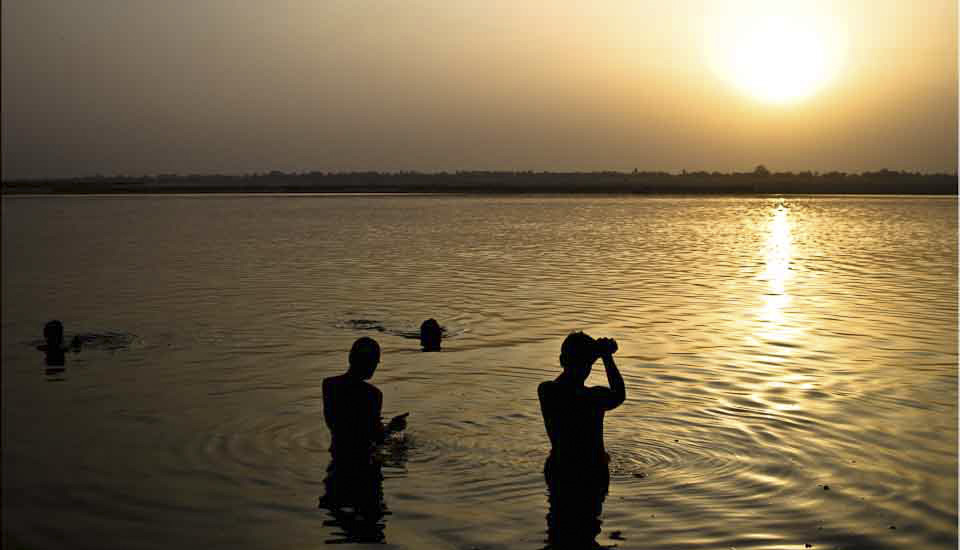




















 How I would have loved to have taken pictures!
How I would have loved to have taken pictures!























 and sleep on the odd floor (with mats and bedding), I know she’d love to have you along to see what is needed for yourself.
and sleep on the odd floor (with mats and bedding), I know she’d love to have you along to see what is needed for yourself..jpg)























 Blue and white ceramics are like a symbolic bridge between the past and the future.
Blue and white ceramics are like a symbolic bridge between the past and the future.









































.png)
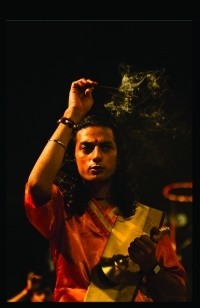
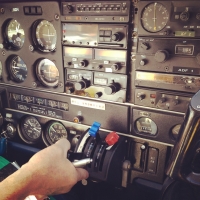
Love this series, some really tremendous environmental portraits. I have booked a few nights at a hotel in Chinatown, as each time I visit it never seems long enough.
Hi Guava! Thanks so much for your comments. Chinatown is, indeed a feast!
Perhaps it’s me but two things stand out in these pictures, the older women who are so poised and the smiles. A quick walk around Liverpool wouldn’t bring such a thought of joy as you work, yet these hard working humble people seem to make the most and best of everything they do, which is something to be admired. Thank as always for sharing your travels, love it!
Too right, Signe! People work long and hard, often under uncomfortable and/or unsafe conditions – and usually with a smile and good humour!
Lovely work sweetie. Love the smiles even after ten years in Bangkok they always seem genuine.
[…] Photo Prompt from Magpie Tales …photo credits here […]
[…] and a wander into the always-photogenic Chinatown, better known locally as Yaowarat (see: A Day in the Life). Our aim was to find Wat Chakkrawadrajawas Woramahavihara, which neither of us had […]